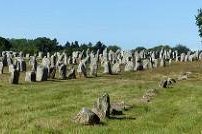
I visited this tentative WHS in July 2016. It definitely deserves inscription as it is one of the best worldwide examples of menhirs, dolmens, tumuli, alignments and megalithic engravings in a relatively compact area. From June to August this site is certainly not off the beaten track and busloads of people visit every day. Due to the fact that most visit during this period, the main alignment fences are closed and one can only enter with a guided visit organised by the Maison des Megalithes (open 10:00 to 19:00) costing 6 euros. If you read up and prepare beforehand or simply if you miss the tour in English, I would suggest visiting before the crowds arrive at 10am and entering the minor free access sites. The surrounding fences are very low and do not obstruct the view of the alignments. I arrived by car at the Maison des Megalithes at around 9am and parked my car for free at the empty parking lot. I had previously downloaded the very good commentary from http://www.brittanytourism.com/discover-our-destinations/southern-brittany-morbihan-gulf/unmissable-sites/carnac and before arriving I bought some food to have breakfast while visiting the alignments. Firstly off I went and walked round the Menec alignments just opposite the parking lot. There are more than 1000 monoliths here, neatly aligned, and incredibly still coexist with a few houses which are inside the fenced off area! The largest monolith here is around 3.5 metres high and is believed to predate the Menec alignments. There are some monoliths which are either very close the fence or actually outside of the fenced area, so really if you want to get up close with the stones you don't have to visit with at least 50 other people herded from one alignment to the next. A minor road which leads to Auray separates the Menec alignments and the Toul-Chignan group which in actual fact must have been the same group. If time is on your side, walking or cycling from the Menec alignments to the Kerlascan alignments is a pleasant 4km one way along the D196. Make sure to bring a hat and lots of water though. Since I also wanted to visit the minor sites and the impressive sites of Locmariaquer and Gavrinis, I decided to move from one alignment to the next by car. Next, I visited the Kermario alignments which are probably the most visited due to their impressive size. At one end of the alignments there is a dolmen without its original cairn and at the other end is a lookout tower to be able to admire the seemingly never-ending alignments. The sheer size and number of monoliths is mindboggling. Here I stopped to enjoy my breakfast at around 10am and I noticed that a number of coaches were all heading towards the Maison des Megalithes so I was glad I the whole site to myself simply because I started my visit an hour before! Quite close to the lookout tower is the Le Manio group which is always open and is surrounded by trees. From here I drove down a narrow road to the Kercado cairn or tumulus (the signage says tumulus!). This site is within a private property belonging to an old lady who collects 1 euro from every visitor and gives a laminated A4 paper in English, French or German with some information. The site is worth visiting and if you look attentively, on the largest slab inside the tumulus you'll be able to see painted axes (similar to the ones I've seen in the Rock Art of the Mediterranean Basin sites I visited in Spain). Next I parked my car near a horse riding school and after a short walk under the shade of tall trees I visited the Manio quadrilateral and the Geant du Manio, the largest monolith of Carnac standing at around 6 metres high! Again, these sites are always open and are not fenced off. Next I visited the Kerlescan alignments towards the end of the D196 where I could clearly see thirteen rows of the best preserved menhirs before heading to the prolongation of this site which is called Le Petit Menec. The Prehistoric Museum in Carnac proper is worth a visit but if you have a car and enough time, make an extra effort and do visit at least the sites in Locmariaquer where you'll be able to see several dolmens but especially the special engravings and ornamental slabs just a few steps from the sea. There were quite a lot of similarities I could notice with other Neolithic engravings I've seen in Ireland and in Malta. Last but not least at lunchtime I visited the small island of Gavrinis (apparently only possible April to October with a guided tour, and July and August possible without a guided tour) which arguably has the best engravings and decorations. You have to bring your own supplies with you but you won't regret it. To visit you have to get on a short 15 minute boat trip from Larmor Baden and you'll have to allow around 2-3 hours. I hope that if the megalithic sites of Carnac get inscribed, the sites at Locmariaquer and Gavrinis get recognition too as they really warrant a complete and unique visit to anyone interested.
More on
Comments
No comments yet.
